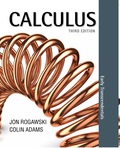
To match the integrals (a)-(e) with their anti-derivatives (i)-(v) on the basis of the general form (do no evaluate the integrals).
Answer to Problem 1CRE
Solution:
We have hence determined that (a) matches (v), (b) matches (iv), (c) matches (iii), (d) matches (i) and (e) matches (ii)
Explanation of Solution
Compare the integrals and the functions without evaluating the integrals to identify the correct match
Given:
(a) (b) (c) (d)
(e)
(i) (ii)
(iii)
(iv) (v)
Calculation:
(a) - since is a constant multiple of the derivative , the substitution method implies that the integral is a constant multiple of that is a constant multiple of . This hence matches the function in (v)
(b) - corresponds to and hence matches (iv)
(c) - the reduction formula shows that this integral is the sum of constant multiples of products and hence matches the function in (iii)
(d) - since which corresponds to the function in (i)
(e) - This one matches the function in (ii)
Conclusion:
We have hence determined that (a) matches (v), (b) matches (iv), (c) matches (iii), (d) matches (i) and (e) matches (ii).
Want to see more full solutions like this?
Chapter 7 Solutions
Calculus: Early Transcendentals
 Calculus: Early TranscendentalsCalculusISBN:9781285741550Author:James StewartPublisher:Cengage Learning
Calculus: Early TranscendentalsCalculusISBN:9781285741550Author:James StewartPublisher:Cengage Learning Thomas' Calculus (14th Edition)CalculusISBN:9780134438986Author:Joel R. Hass, Christopher E. Heil, Maurice D. WeirPublisher:PEARSON
Thomas' Calculus (14th Edition)CalculusISBN:9780134438986Author:Joel R. Hass, Christopher E. Heil, Maurice D. WeirPublisher:PEARSON Calculus: Early Transcendentals (3rd Edition)CalculusISBN:9780134763644Author:William L. Briggs, Lyle Cochran, Bernard Gillett, Eric SchulzPublisher:PEARSON
Calculus: Early Transcendentals (3rd Edition)CalculusISBN:9780134763644Author:William L. Briggs, Lyle Cochran, Bernard Gillett, Eric SchulzPublisher:PEARSON Calculus: Early TranscendentalsCalculusISBN:9781319050740Author:Jon Rogawski, Colin Adams, Robert FranzosaPublisher:W. H. Freeman
Calculus: Early TranscendentalsCalculusISBN:9781319050740Author:Jon Rogawski, Colin Adams, Robert FranzosaPublisher:W. H. Freeman
 Calculus: Early Transcendental FunctionsCalculusISBN:9781337552516Author:Ron Larson, Bruce H. EdwardsPublisher:Cengage Learning
Calculus: Early Transcendental FunctionsCalculusISBN:9781337552516Author:Ron Larson, Bruce H. EdwardsPublisher:Cengage Learning





